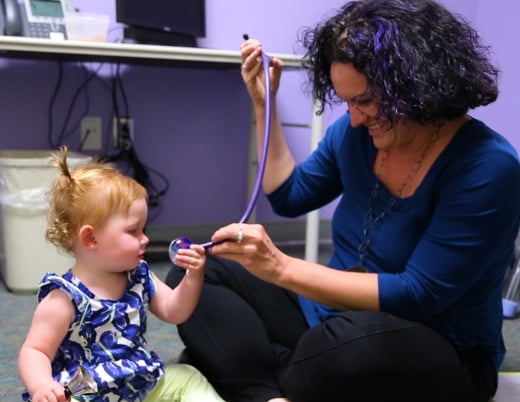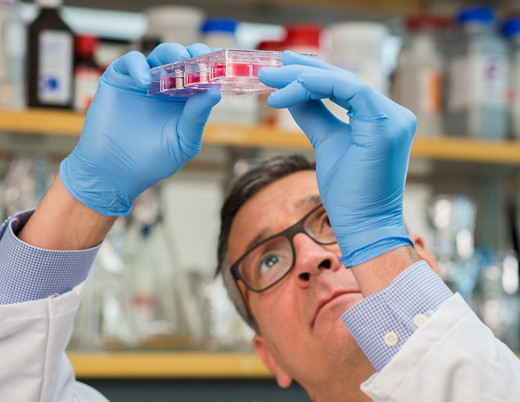Key takeaways
-
This study presents significant new research findings regarding pediatric high-grade glioma, with insights into how heterogeneity occurs and why it makes these tumors resistant to treatment.
-
The multiple tumor cell types identified in the study originate from different normal brain cells, rely on different pathways to support tumor growth, and will likely require differing therapeutics to control overall tumor growth.
-
The study discovered that tumor resident macrophages may drive formation and growth of mesenchymal-like cells that vary from the other tumor types and will likely require distinct treatment strategies.
-
The results of the study open the door for the development of much needed combination therapies for pediatric high-grade glioma patients.
Research study background
Pediatric high-grade gliomas are aggressive, treatment-resistant brain tumors. Depending on the subtype, five-year survival rates range from less than 2% to 20%. It has been difficult to develop therapies for PHGG due to varied presentation in individual patients. The broad inter- and intra-tumoral heterogeneity has limited our understanding and characterization of basic tumor biology.
In this study, neuro-oncology researchers from the Center for Cancer and Blood Disorders at Children’s Hospital Colorado hypothesized that PHGG's heterogeneity stems from diverse proportions of distinct tumor and immune cell types influencing tumor characteristics. The study identifies normal central nervous system (CNS) cell types comparable to PHGG cells, examines immune cells in both the CNS and systemic circulation in PHGG and explores potential tumor-immune cell interactions.
The research team performed single-cell RNA-Seq (scRNA-Seq), bulk methylation and bulk RNA-Seq on 19 PHGG samples from the hospital's brain tumor bank. This work established a comprehensive, single-cell transcriptomic data set and included capturing immune cell data, which has previously been understudied.
The scRNA-Seq analysis distinguished tumors from immune cells and identified multiple subtypes of each. Among the diverse tumor cell types identified in the PHGG samples, three principal cell types emerged: astrocytes, oligodendrocyte progenitor cells (OPC) and OPC-derived mesenchymal-like cells (Mes). Each exhibited distinct gene expression profiles, pathway enrichment and degrees of mesenchymal character.
Immune cell analysis pinpointed a macrophage population with elevated mesenchymal and inflammatory gene expression that likely sparks the onset of tumor cells with mesenchymal characteristics. Study authors also identified gene expression markers and immunofluorescence staining patterns consistent with T-cell exhaustion and suppression.
Clinical implications
Taken together, these findings suggest PHGG involves various actively growing tumor cell types, potentially impacted by microglia-derived macrophages, with predicted Mes tumor cells likely originating from OPCs. The variable tumor cell populations appear to rely on different oncogenic pathways and may respond differently to therapy.
Future research should focus on understanding how tumor resident macrophages contribute to the mesenchymal tumor environment and how the individual tumor cell types react to variable combinations of radiotherapy and chemotherapy. Study authors believe these findings provide valuable insights for the development of treatment strategies to target specific oncogenic processes in diverse PHGG tumor cell types.
Featured researchers
John DeSisto, MS, JD
Senior professional research assistant
Pediatric Hematology/Oncology and Bone Marrow Transplantation
University of Colorado School of Medicine
Andrew Donson, PhD
Senior research associate
Pediatrics-Hematology/Oncology and Bone Marrow Transplantation
University of Colorado School of Medicine
Andrea Griesinger, MS
Research Associate
Pediatrics-Hematology/Oncology and Bone Marrow Transplantation
University of Colorado School of Medicine

Nick Foreman, MD
Seebaum/Tschetter Chair of Pediatric Neuro-Oncology
Center for Cancer and Blood Disorders
Children's Hospital Colorado
Professor
Pediatrics-Hematology/Oncology and Bone Marrow Transplantation
University of Colorado School of Medicine

Rajeev Vibhakar, MD, PhD, MPH/MSPH
Pediatric oncologist
Center for Cancer and Blood Disorders
Children's Hospital Colorado
Professor
Pediatrics - Hematology/Oncology and Bone Marrow Transplantation
University of Colorado School of Medicine

Adam Green, MD
Pediatric neuro-oncologist
Center for Cancer and Blood Disorders
Children's Hospital Colorado
Associate professor
Pediatrics-Hematology/Oncology and Bone Marrow Transplantation
University of Colorado School of Medicine





 720-777-0123
720-777-0123










